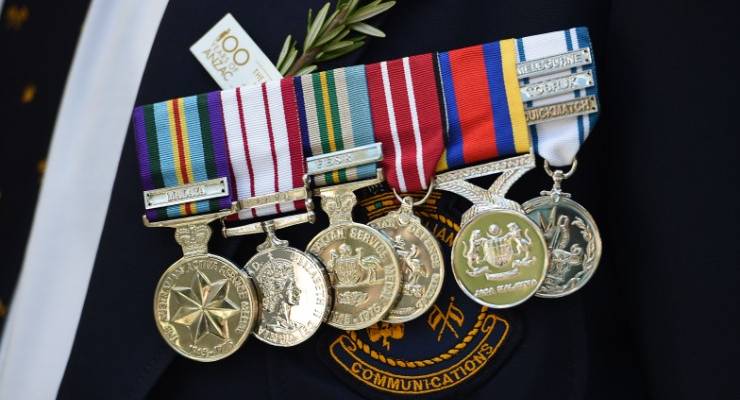
If you’re a big institution with close to 200,000 members, almost $1 billion in assets and more than 100 years of history, you would think it wouldn’t be too hard to run a professional annual general meeting which is open and transparent.
Sadly, judging by what it served up at its state conference last Thursday, RSL Victoria has a long way to go.
For starters, the rules of the day gave the discretion to chairman Rob Webster to ban the media. And that’s precisely what he did.
So when ABC Victoria’s state political reporter Richard Willingham turned up at Caulfield Racecourse at 9.30am as proceedings were getting under way, he was refused entry — even as an observer with no camera crew or recording devices.
The only coverage from the meeting was produced by Lisa Martin from The Guardian, who simply sat outside the main hall in the lobby and listened to what was being said over the loud speakers. Clever, but should this be necessary?
I was able to live-tweet the state conference but only because an RSL sub-branch had registered me as an official observer and that meant sitting way off to the side where you couldn’t see the screen or make out who was sitting at the top table. If any photos or audio was tweeted, I would have been promptly evicted.
The AGM drew a near-record crowd of more than 500, partly because a group of younger veterans had run a noisy campaign calling for reforms such as greater investment in veteran services, more aggressive advocacy, divestment from the pokies industry, the appointment of female directors and reforms like one member one vote for service members at AGMs.
The reformers had written to the board requesting 18 constitutional amendments, but these were largely ignored. They then requested a series of transparency measures at the AGM but most of these were refused by the old guard too.
So, let’s go through what should have happened if RSL Victoria had run a model AGM and hope this can be an example for other institutions.
Firstly, all the relevant documents should have been emailed to members and made available on the RSL Victoria website at least 28 days before the AGM. This is what all public companies are required to do.
Sadly, five days after the AGM, there is still no documentation on the RSL Victoria website related to the AGM. It may as well not have happened. Seeing as the old guard won’t publish basic information, let’s give them a hand. Here is the 30-page agenda, the 36-page president’s report and 29 pages of financial reports.
The financials proved to be a bit of joke; they were amended at the AGM to bump the pay of two key management personnel up by $100,000 to more than $800,000. Apparently their free cars weren’t included.
Ideally, the key documents would have been emailed to all members well in advance of the AGM, but instead RSL Victoria is running on the antiquated delegate model where the only people who get told anything are sub-branch committees and the delegates they appoint to attend the state conference.
Indeed, so controlling was the RSL board, they initially proposed clearing the room of everyone but delegates and staff during the three-hour forum which ran from 2.30pm until 5.30pm last Thursday.
When it was pointed out that Victorian law requires ordinary members to attend and participate in an AGM once a year, they lifted the ban on non-delegate RSL members from attending the forum, but only registered delegates were allowed to speak.
The board was also asked to embrace transparency through measures such as a live broadcast of the AGM, plus the provision of a full transcript of proceedings for interested members. Alas, this was rejected too.
While you expect military organisations to be a little command-and-control in the way they go about it, I’ve never seen an AGM like Thursday’s where delegates had to sit at allocated tables. This made it difficult for the young reformers from different sub-branches who weren’t even allowed to sit together and instead had to rely on WhatsApp to co-ordinate their questioning.
The old guard may have got through Thursday’s AGM relatively unscathed — save for 90 minutes of sharp questioning from the younger veterans in the latter part of the day — but they really do need to embrace the 21st century.
With no female directors, a CEO who has been in the job since 2007 and a president who has been on the board since 1989, is it any wonder that RSL Victoria is running like an antiquated organisation? For an organisation that represents the soldiers who risked their lives to defend Australian freedom and democracy, maybe the RSL should think about practicing some freedom and democracy of its own.
What other Australian organisations could use a little more interrogation and transparency? Send suggestions or tips to boss@crikey.com.au








Defensive rearguard actions are always untidy and somewhat chaotic – Dunkirk is a classic example – you’re in retreat after all, and probably in denial that you are about to lose. The younger reformers will carry the day and ultimately the old guard will have to give way to good sense, proper procedure & practice and the future.
Sums it up well
”With no female directors, a CEO who has been in the job since 2007 and a president who has been on the board since 1989, is it any wonder that RSL Victoria is running like an antiquated organisation? For an organisation that represents the soldiers who risked their lives to defend Australian freedom and democracy, maybe the RSL should think about practicing some freedom and democracy of its own.”
Good report SM. What a travesty. Hopefully this will change if the younger members keep pushing.
The old guard will eventually pass away, at that point will the RSL still exist? The young RSL members will have left to form their own organisation.
As usual, Stephen shows how to do journalism.
Nobody could be less interested in this story without being dead but I found his forensic detail fascinating.
Well done, that Mayne.
It’s actually the young reformers themselves, particularly Lucas Moon, who did most of the work to unearth this cesspit. See this back catalogue of email updates from the reformers for more: https://us20.campaign-archive.com/home/?u=0e125abe4de9847f586398e4b&id=b06cdb006a